Brain Tumor Therapeutics Market Size
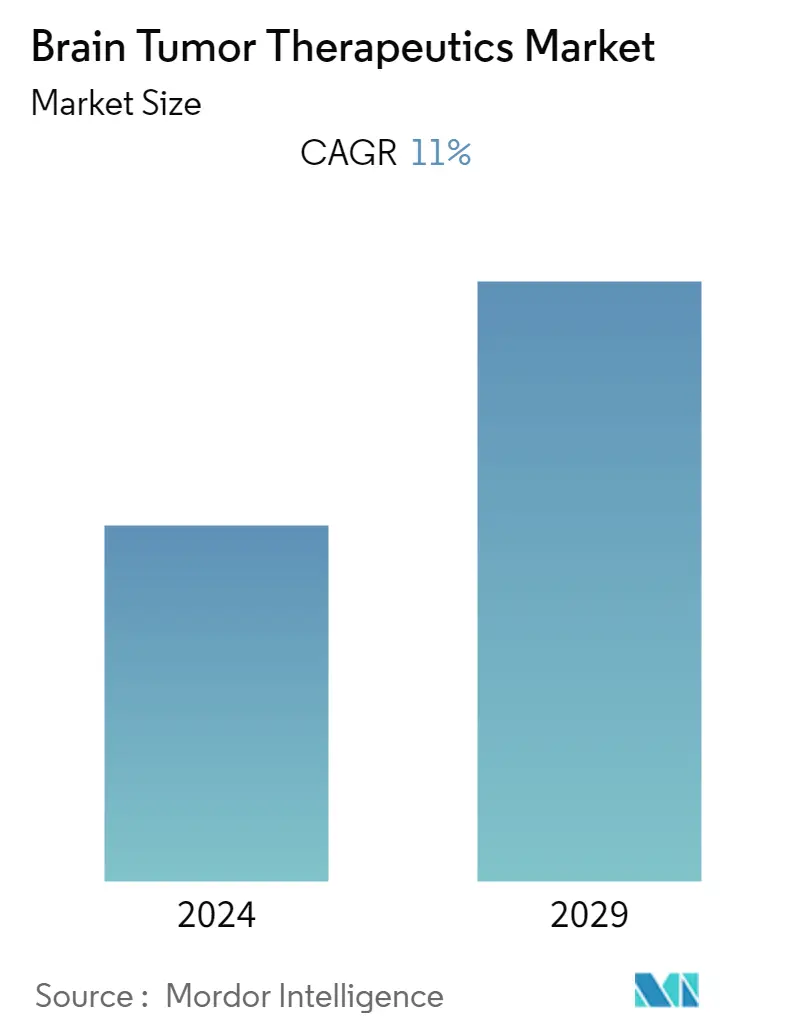
| Study Period | 2019 - 2029 |
| Base Year For Estimation | 2023 |
| CAGR | 11.00 % |
| Fastest Growing Market | Asia Pacific |
| Largest Market | North America |
| Market Concentration | High |
Major Players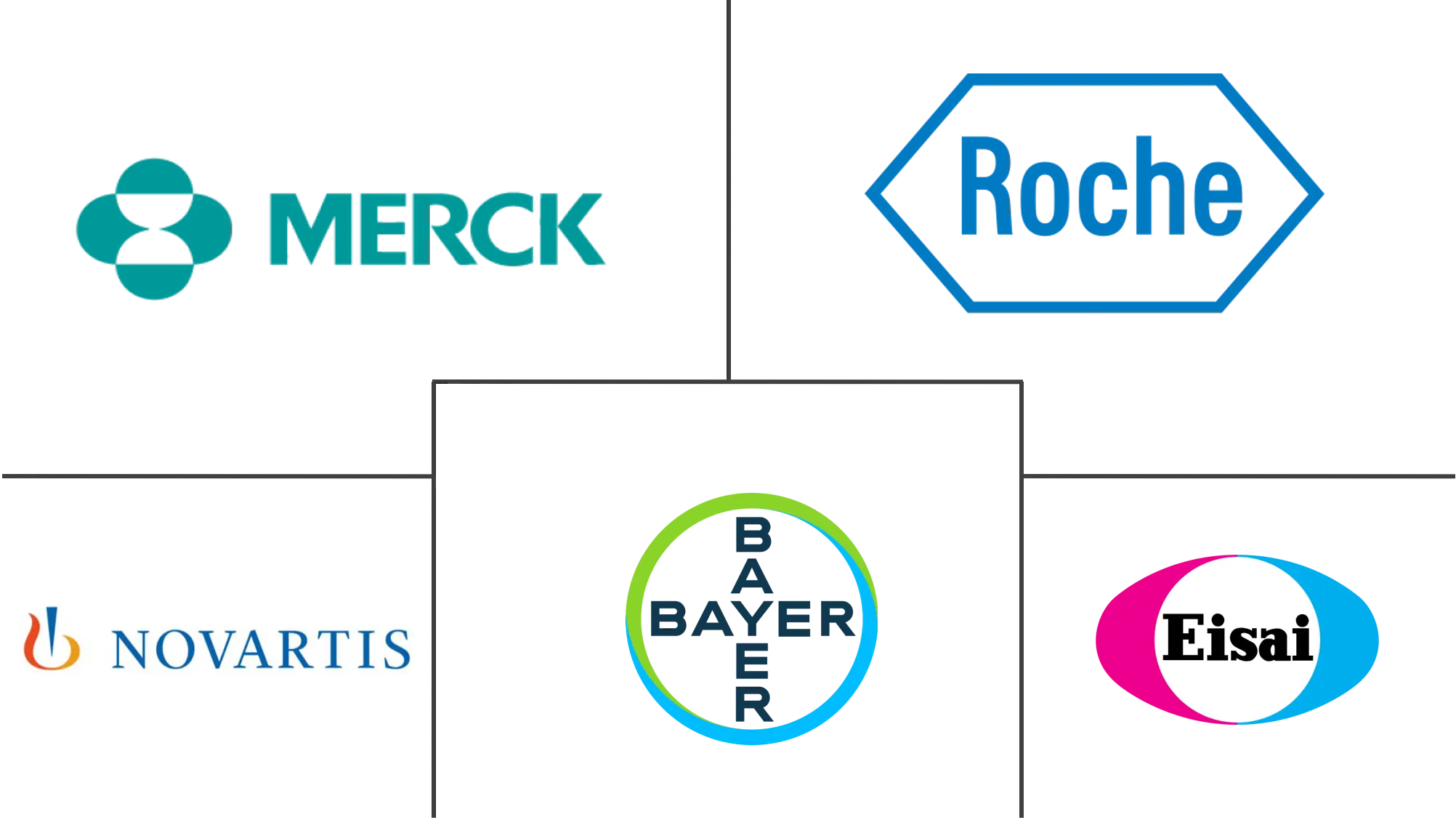
*Disclaimer: Major Players sorted in no particular order |
Brain Tumor Therapeutics Market Analysis
The brain tumor therapeutics market is valued at USD 2.70 billion and is expected to reach to USD 4.5 billion registering a CAGR of 11.0% during the forecast period.
COVID-19 impacted the brain tumor therapeutics market significantly due to the delayed diagnosis and scarcity of medications. For instance, as per the article published in January 2021 in Elsevier, a delay or modification in therapy compromised the effectiveness and lowered patients' survival rates. Also, delayed diagnosis of brain tumors was correlated with a worse prognosis. This further impacted the growth of the brain tumor therapeutics market during the pandemic. However, the market is anticipated to grow in the coming years due to the rise in brain tumor cases and increased research and development for brain tumor therapeutics.
Factors such as the rise in brain tumor cases, increased brain tumor therapeutics product launches, and a surge in cancer awareness campaigns focusing on the importance of brain tumor medications are anticipated to boost market growth over the forecast period. For instance, per the NBTS, an estimated 94,390 people in the United States will likely receive a primary brain tumor diagnosis in 2023. This increase in cancer cases is expected to drive the overall brain therapeutics market. Glioblastoma is an aggressive form of brain tumor that occurs mainly in adults. It can also occur in children, but very rarely. It grows fast and spreads quickly. Quick diagnosis and treatment are necessary, as it is a fatal disorder. Proper diagnosis and therapies can alleviate the complications associated with the disease. Hence, as the number of glioblastoma cases increases, the demand for brain tumor therapeutics rises, boosting market growth over the forecast period.
Furthermore, an increase in research and development, product launches, and collaborations by the key players are anticipated to drive market growth. For instance, in June 2022, The FDA approved the combination of the targeted drugs dabrafenib (Tafinlar) and trametinib (Mekinist) for the treatment of people with nearly any type of advanced solid tumor that has a specific mutation in a gene called BRAF. Results from three clinical trials, including two with adult patients and one with pediatric patients, provided the data for approval. Some trial participants had rare cancers, including glioma (brain cancer). In addition, in November 2021, The Ivy Brain Tumor Center at Barrow Neurological Institute and UC San Francisco reported the opening of a Phase 0 clinical trial to evaluate niraparib (ZEJULA), an oral, once-daily poly (ADP-ribose) polymerase (PARP) inhibitor from GSK, for patients with newly diagnosed glioblastoma (GBM) and recurrent glioma (grades II-IV).
Thus, due to the increase in the prevalence of brain tumors and the rise in research and development in the field of brain tumor therapeutics development, the brain tumor therapeutics market is anticipated to witness growth over the forecast period. However, the high cost of cancer therapy and side effects associated with brain tumor therapeutics are projected to hamper market growth over the forecast period.
Brain Tumor Therapeutics Market Trends
The Immunotherapy Segment is Expected to Register Robust Growth in the Brain Tumor Therapeutics Market Over the Forecast Period
Immunotherapy is a cancer treatment that helps the immune system fight cancer. There are several types of immunotherapies used for the treatment of cancer. Immunotherapy offers promising options for treating brain cancer, traditionally treated with chemotherapy, radiation therapy, and surgery. Immunotherapy, also called biological therapy, treats the disease using living organisms. The Immunotherapy segment is anticipated to witness growth in the market owing to factors such as a rise in the adoption of immunotherapies for brain tumor treatments, an increase in product launches in cancer immunotherapy, and the surge in research funding for the development of immunotherapy. For instance, per the article published in the World Journal of Clinical Oncology in April 2023, a combination of immunotherapies is used for glioblastoma to reduce collateral damage and improve recovery. Thus, owing to such advantages offered by immunotherapies in brain tumors, the demand for the studied segment will likely rise, contributing to the segment growth over the forecast period.
The development of this market is anticipated to be fueled by novel immunotherapy strategies for brain cancer. Additionally, there are many approved immunotherapies for various brain cancers, and market players and universities are significantly focusing on developing and launching new immunotherapies for brain tumors. For instance, in February 2022, Augusta University collaborated with a researcher to find the efficacy of repurposing Ibrutinib for Chemo-Immunotherapy in Phase 1b Study of Ibrutinib with Indoximod Plus Metronomic Cyclophosphamide and Etoposide for pediatric patients with brain cancer. Therefore, this market is anticipated to rise due to universities' increasing attempts to create novel immunotherapy treatments. Thus, the factors above have helped drive the market's overall growth.
Thus, due to the increase in the prevalence of brain tumors and the rise in research and development in immunotherapy in brain tumors, the immunotherapy segment is anticipated to witness growth over the forecast period.
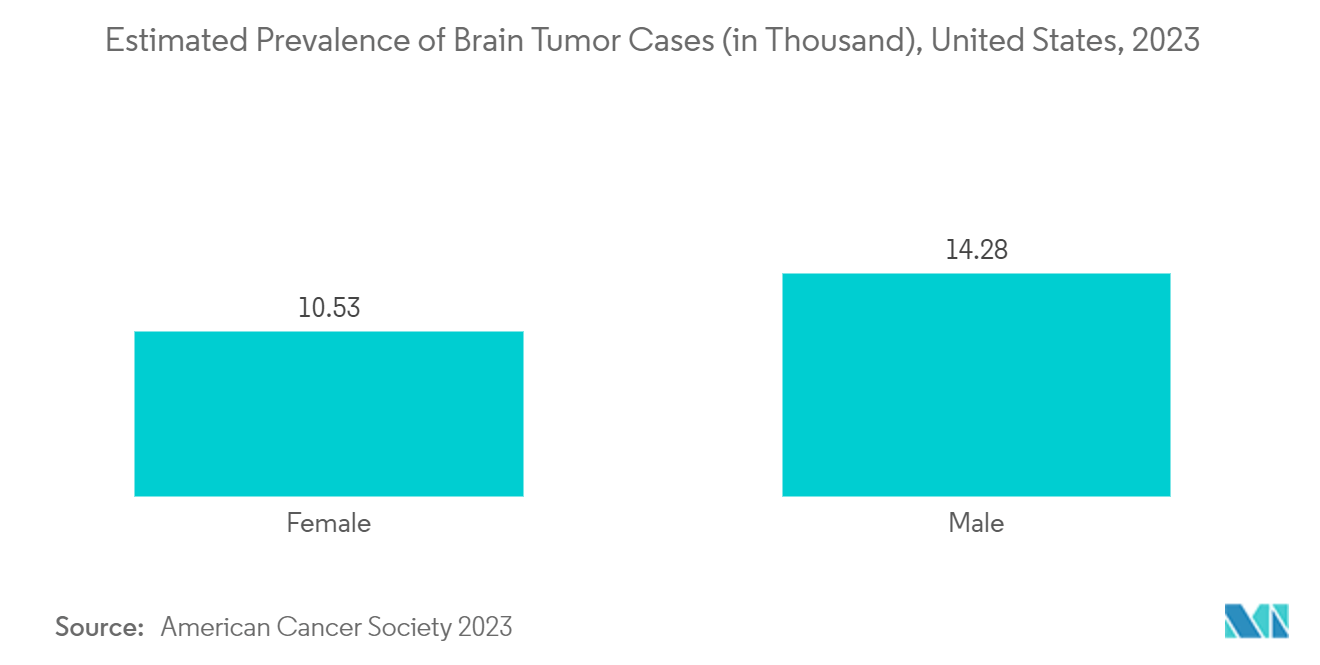
North America is Anticipated to Witness a Growth in the Brain Tumor Therapeutics Market Over the Forecast Period
North America's brain tumor therapeutics market is projected to have a significant share over the forecast period owing to factors such as a rise in brain tumor complications, a developed healthcare industry, and rising awareness regarding advanced technologies among the population in this region. According to the American Brain Tumor Association, approximately 24,810 adults in the United States will likely be diagnosed with primary cancerous brain and spinal cord tumors in 2023. Similarly, per the Cancer Canada statistics, 3,200 Canadians were diagnosed with brain and spinal cord cancer in 2022. The high prevalence of brain tumors is expected to drive the growth of this region.
Moreover, frequent product launches, drug approvals, and significant R&D activities for treating brain tumors will likely drive the market studied in the United States. For instance, in October 2022, the Governing Board of the California Institute for Regenerative Medicine (CIRM) awarded USD 12 million for a clinical trial targeting brain tumors. The fund was awarded to Dr. Jana Portnow at the Beckman Research Institute of the City of Hope. They are using Neural stem cells (NSCs) as a delivery vehicle to carry a cancer-killing virus specifically targeting brain tumor cells. The increasing research and development and funding in North America for brain tumor therapeutics are expected to propel the growth of this market.
Thus, North America is anticipated to witness growth over the forecast period due to the increase in the prevalence of brain tumors and the rise in research and development in the field of brain tumors.
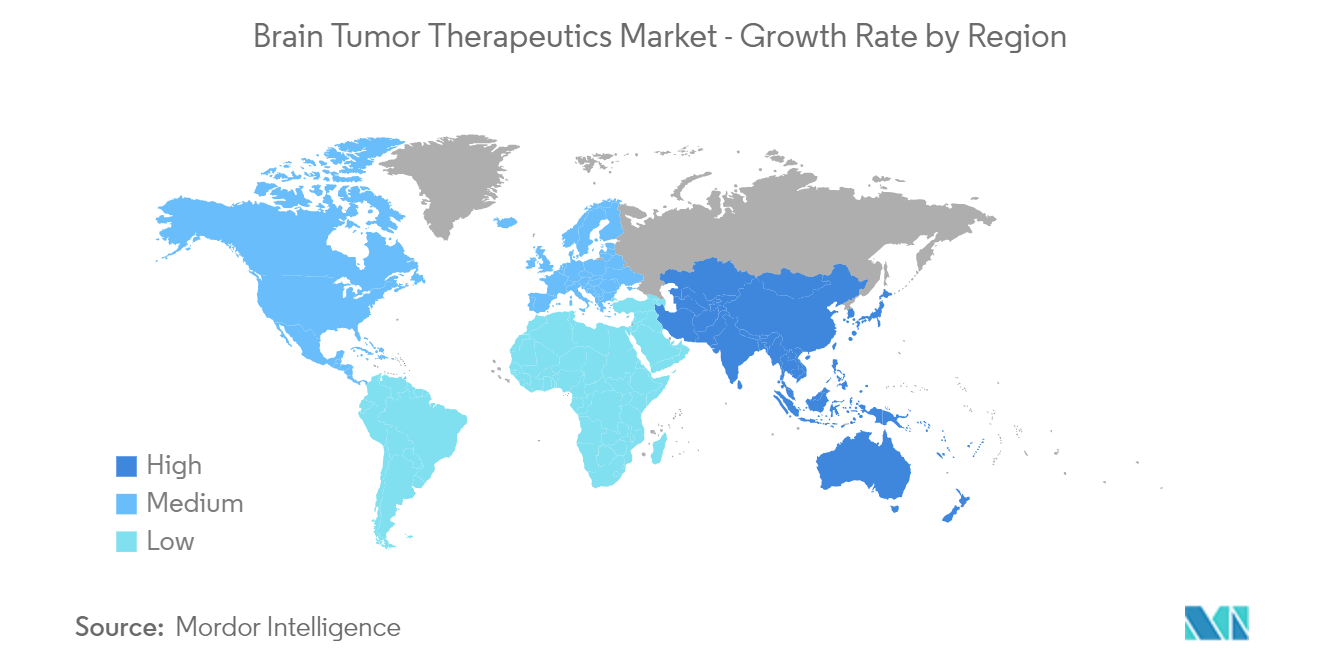
Brain Tumor Therapeutics Industry Overview
The market for brain tumor therapeutics is moderately fragmented, consisting of various players controlling a significant market share. Key players in the market include Amgen Inc., AstraZeneca PLC, Bayer AG, Bristol-Myers Squibb Co, F. Hoffmann-La Roche Ltd, GlaxoSmithKline PLC, Johnson & Johnson, Merck & Co. Inc., Novartis AG, and Pfizer Inc., among others.
Brain Tumor Therapeutics Market Leaders
-
Bayer AG
-
F. Hoffmann-La Roche Ltd
-
Eisai Inc.
-
Novartis AG
-
Merck & Co. Inc.
*Disclaimer: Major Players sorted in no particular order
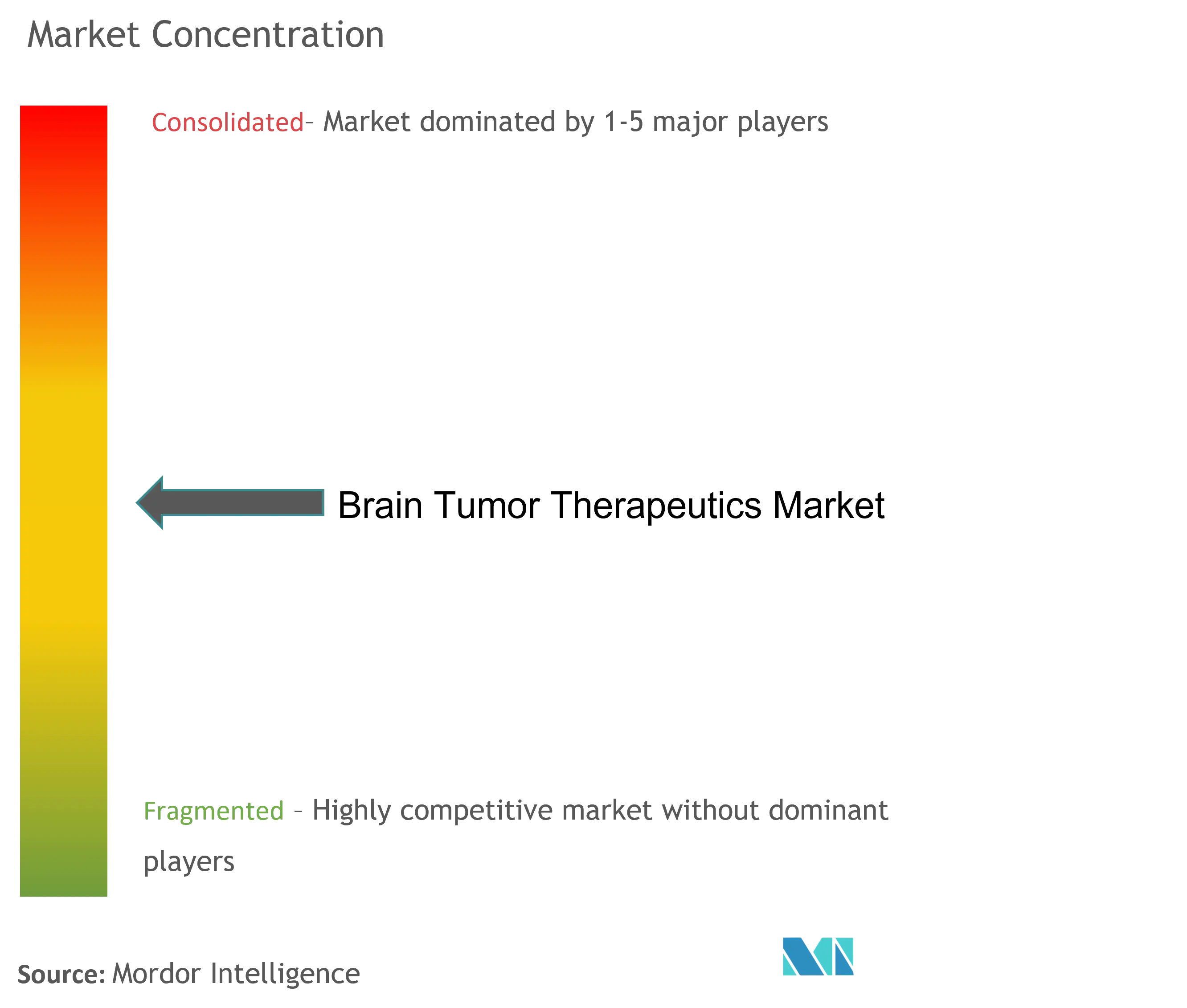
Brain Tumor Therapeutics Market News
- June 2023: Erasca, Inc., a clinical-stage precision oncology company, received the United States Food and Drug Administration (FDA) Orphan Drug Designation (ODD) to ERAS-801 for the treatment of malignant glioma, which includes glioblastoma (GBM). ERAS-801 is an orally bioavailable, small-molecule EGFR inhibitor that exhibited substantial central nervous system (CNS) penetration in preclinical animal studies.
- January 2023: Stanford University collaborated with the Invus Group, an investment firm, to develop treatments for glioblastoma. Invus funded two projects at the Stanford Innovative Medicines Accelerator (IMA) to develop a small-molecule or protein drug prototype that treats the disease.
Brain Tumor Therapeutics Market Report - Table of Contents
1. INTRODUCTION
- 1.1 Study Assumptions and Market Definition
- 1.2 Scope of the Study
2. RESEARCH METHODOLOGY
3. EXECUTIVE SUMMARY
4. MARKET DYNAMICS
- 4.1 Market Overview
-
4.2 Market Drivers
- 4.2.1 Rising Incidence of Brain Tumor
- 4.2.2 Strong R&D Initiatives from Key Players
- 4.2.3 Increasing Government Initiatives for Cancer Awareness
-
4.3 Market Restraints
- 4.3.1 High Cost of Cancer Therapies
-
4.4 Porter's Five Forces Analysis
- 4.4.1 Bargaining Power of Buyers/Consumers
- 4.4.2 Bargaining Power of Suppliers
- 4.4.3 Threat of New Entrants
- 4.4.4 Threat of Substitute Products
- 4.4.5 Intensity of Competitive Rivalry
5. MARKET SEGMENTATION (Market Size by Value - USD)
-
5.1 By Type of Brain Cancer
- 5.1.1 Glioblastoma
- 5.1.2 Meningioma
- 5.1.3 Pituitary Tumors
- 5.1.4 Other Types of Brain Cancer
-
5.2 By Therapy
- 5.2.1 Chemotherapy
- 5.2.2 Immunotherapy
- 5.2.3 Gene Therapy
- 5.2.4 Other Therapies
-
5.3 Geography
- 5.3.1 North America
- 5.3.1.1 United States
- 5.3.1.2 Canada
- 5.3.1.3 Mexico
- 5.3.2 Europe
- 5.3.2.1 Germany
- 5.3.2.2 United Kingdom
- 5.3.2.3 France
- 5.3.2.4 Italy
- 5.3.2.5 Spain
- 5.3.2.6 Rest of Europe
- 5.3.3 Asia-Pacific
- 5.3.3.1 China
- 5.3.3.2 Japan
- 5.3.3.3 India
- 5.3.3.4 Australia
- 5.3.3.5 South Korea
- 5.3.3.6 Rest of Asia-Pacific
- 5.3.4 Middle East and Africa
- 5.3.4.1 GCC
- 5.3.4.2 South Africa
- 5.3.4.3 Rest of Middle East and Africa
- 5.3.5 South America
- 5.3.5.1 Brazil
- 5.3.5.2 Argentina
- 5.3.5.3 Rest of South America
6. COMPETITIVE LANDSCAPE
-
6.1 Company Profiles
- 6.1.1 Amgen Inc.
- 6.1.2 AstraZeneca PLC
- 6.1.3 Bayer AG
- 6.1.4 Bristol-Myers Squibb Company
- 6.1.5 Eisai Co., Ltd.
- 6.1.6 F. Hoffmann-La Roche Ltd
- 6.1.7 GSK plc
- 6.1.8 Johnson & Johnson
- 6.1.9 Merck & Co. Inc.
- 6.1.10 Novartis AG
- 6.1.11 Pfizer Inc.
- *List Not Exhaustive
7. MARKET OPPORTUNITIES AND FUTURE TRENDS
** Subject To AvailablityBrain Tumor Therapeutics Industry Segmentation
As per the report's scope, brain tumor arises from the abnormal growth of cancerous cells in the brain. A brain tumor is one of the leading causes of death globally. Meningioma is the most common kind of brain tumor and the hardest to treat, while treatments for glioma usually have better outcomes. The Brain Tumor Therapeutics Market is Segmented by Type of Brain Cancer (Glioblastoma, Meningioma, Pituitary Tumors, and Other Types of Brain Cancer), Therapy (Chemotherapy, Immunotherapy, Gene Therapy, and Other Therapies), and Geography (North America, Europe, Asia-Pacific, Middle East and Africa, and South America). The report also covers the estimated market sizes and trends for 17 countries across major regions globally. The report offers the value (in USD) for the above segments.
| By Type of Brain Cancer | Glioblastoma | |
| Meningioma | ||
| Pituitary Tumors | ||
| Other Types of Brain Cancer | ||
| By Therapy | Chemotherapy | |
| Immunotherapy | ||
| Gene Therapy | ||
| Other Therapies | ||
| Geography | North America | United States |
| Canada | ||
| Mexico | ||
| Geography | Europe | Germany |
| United Kingdom | ||
| France | ||
| Italy | ||
| Spain | ||
| Rest of Europe | ||
| Geography | Asia-Pacific | China |
| Japan | ||
| India | ||
| Australia | ||
| South Korea | ||
| Rest of Asia-Pacific | ||
| Geography | Middle East and Africa | GCC |
| South Africa | ||
| Rest of Middle East and Africa | ||
| Geography | South America | Brazil |
| Argentina | ||
| Rest of South America |
Brain Tumor Therapeutics Market Research FAQs
What is the current Global Brain Tumor Therapeutics Market size?
The Global Brain Tumor Therapeutics Market is projected to register a CAGR of 11% during the forecast period (2024-2029)
Who are the key players in Global Brain Tumor Therapeutics Market?
Bayer AG, F. Hoffmann-La Roche Ltd, Eisai Inc., Novartis AG and Merck & Co. Inc. are the major companies operating in the Global Brain Tumor Therapeutics Market.
Which is the fastest growing region in Global Brain Tumor Therapeutics Market?
Asia Pacific is estimated to grow at the highest CAGR over the forecast period (2024-2029).
Which region has the biggest share in Global Brain Tumor Therapeutics Market?
In 2024, the North America accounts for the largest market share in Global Brain Tumor Therapeutics Market.
What years does this Global Brain Tumor Therapeutics Market cover?
The report covers the Global Brain Tumor Therapeutics Market historical market size for years: 2019, 2020, 2021, 2022 and 2023. The report also forecasts the Global Brain Tumor Therapeutics Market size for years: 2024, 2025, 2026, 2027, 2028 and 2029.
Global Brain Tumor Therapeutics Industry Report
Statistics for the 2024 Brain Tumor Therapeutics market share, size and revenue growth rate, created by Mordor Intelligence™ Industry Reports. Brain Tumor Therapeutics analysis includes a market forecast outlook to for 2024 to 2029 and historical overview. Get a sample of this industry analysis as a free report PDF download.



